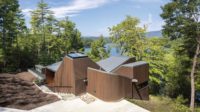Loblolly House
On a wooded site on Taylors Island, Maryland, KieranTimberlake tested a new way of building with the Loblolly house
Stephen Kieran, FAIA, likens his family’s new weekend house on Taylors Island in Maryland to a duck blind, one of those three-sided shelters that hunters build to make themselves disappear in the woods or a marsh. Barklike vertical strips of red cedar clad three elevations of Kieran’s 2,200-square-foot house, camouflaging it on a 4-acre Chesapeake Bay site thick with loblobby pines. While those mostly opaque sides face the surrounding forest, the fourth elevation literally opens to the water—thanks to retractable translucent hangar doors and accordion-folding glass walls that the owners can move to eliminate all separation between indoors and out.
And like a duck blind, the building—which the architect calls the Loblolly House—can be disassembled. Most of its pieces are then recyclable. Concern for the environment has long been essential to the work of KieranTimberlake Associates, Kieran’s Philadelphia-based firm. But in the past few years, the practice has also investigated modular and prefabricated construction with the aim of developing faster, cheaper, and smarter ways of building. “Forty percent of the material in landfills is building debris,” notes Kieran. “If you could take apart a building and sell elements from it on eBay, you could make a difference.”
But most attempts at prefabrication in building construction have failed, he says, due to economics, market perceptions, and peculiarities of the home-building industry. Traditional construction methods have long been less expensive than prefab experiments, and perceived by the public as being of higher quality. In the past few years, though, the costs of on-site construction have soared, while the industry has faced serious quality concerns, says Kieran. At the same time, the quality of factory-built components and consumer interest in prefab have risen.
The one earlier example of successful industrialization in American home building—manufactured houses delivered by truck to sites all over the country—holds no appeal for Kieran and his partner, James Timberlake, FAIA. “You’re stuck with dimensions and limitations determined by highway transportation rules. That’s the death of architecture,” Kieran maintains. “No matter what you do, you always read the single- or double-wide trailer in those homes.”
KieranTimberlake saw the three-story Loblolly House as a system made entirely of off-the-shelf elements and components fabricated off-site to be assembled atop a platform (or “foundation”) of wooden piles sunk into the sandy soil. Key components included so-called “smart cartridges” used to create floors, ceilings, and roof; “dumb cartridges” for the building’s skin; and “blocks” that house bathrooms or mechanical rooms.





